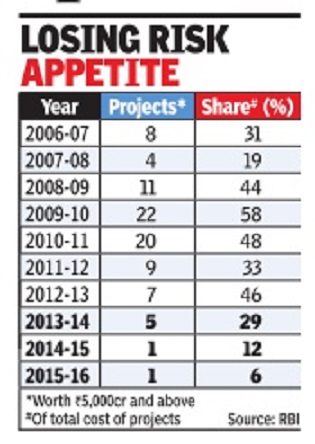Investments: India
This is a collection of articles archived for the excellence of their content. |
Contents |
Equity
2018> 19

From: Nov 1, 2019: The Times of India
See graphic:
Composition of direct equity holding based on investor class, 2018- 19
Gross fixed capital formation
2003-17
February 2, 2018: The Times of India
Soaring stock prices, pick-up in industrial production, stabilising GST regime and a projected upturn in GDP growth-there has been a raft of good economic news in the past few weeks. But the good times won’t roll on unless the rate of new investment, especially private investment, picks up soon. Here’s how severe the slowdown is and what’s causing it
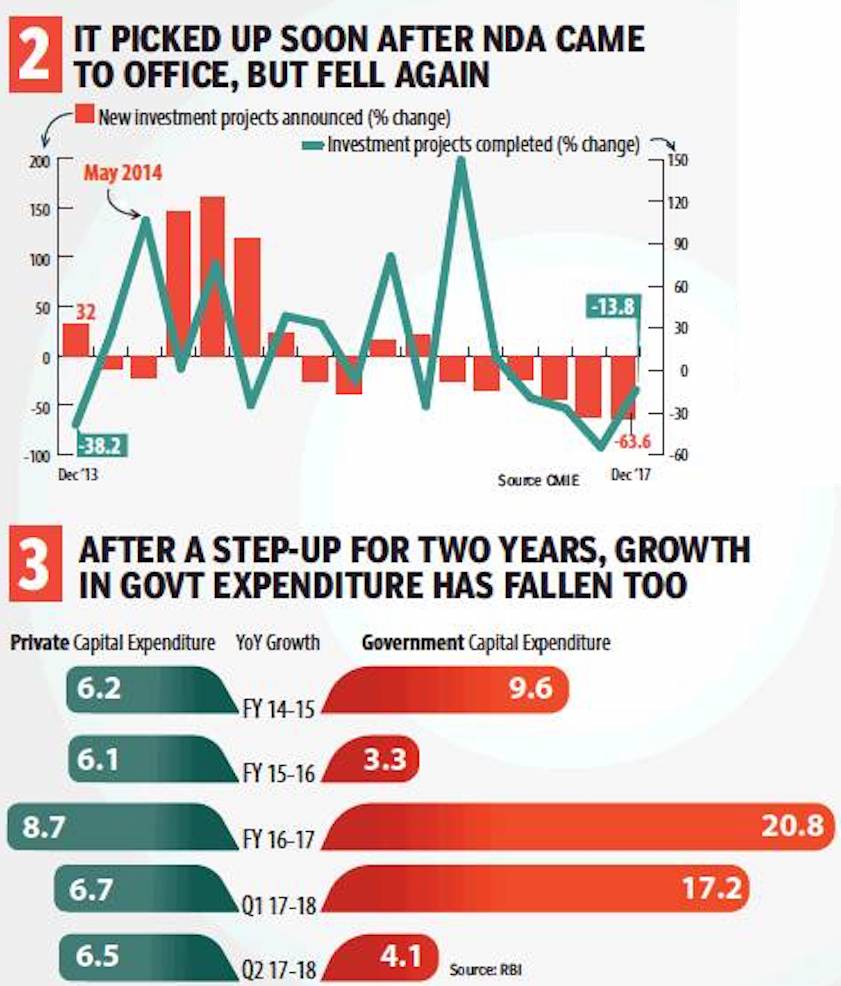
ii) Government and private capital expenditure, 2014-18
From: February 2, 2018: The Times of India
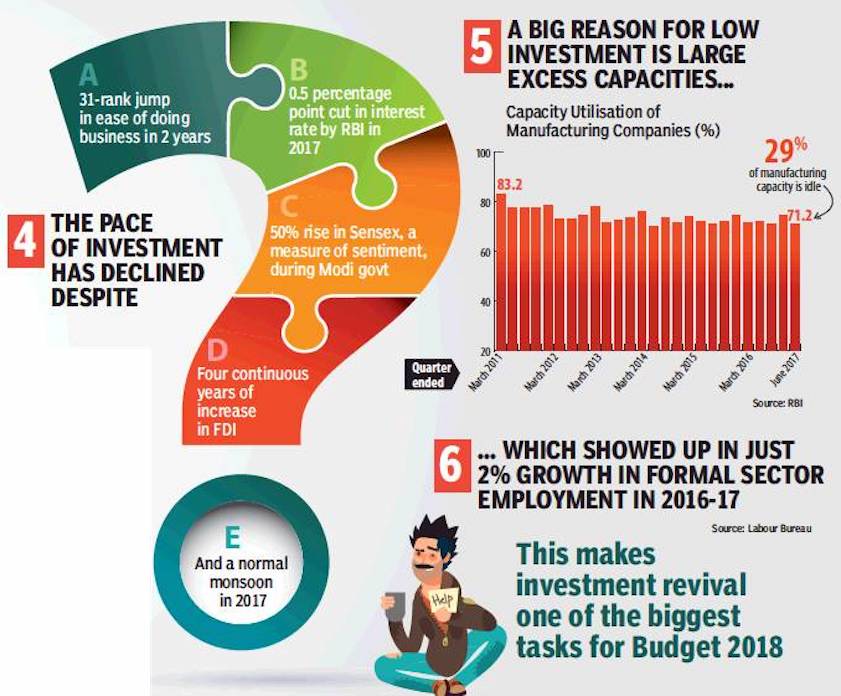
ii) its impact on growth of employment in 2017
From: February 2, 2018: The Times of India
See graphics:
1. Gross fixed capital formation, 2003-16,
i) as percentage of GDP;
ii) annual change
2. i) The rise and fall of gross fixed capital formation, 2013-17,
ii) Government and private capital expenditure, 2014-18
3. i) Capacity utilisation of manufacturing companies (%), 2011-17;
ii) its impact on growth of employment in 2017
Impact investments
2017>2019
Digbijay Mishra, July 22, 2019: The Times of India

Sectors funded, sources of funds, Definition
From: Digbijay Mishra, July 22, 2019: The Times of India
Impact investments, a pathway to achieve the seemingly divergent goals of financial returns and social good, are moving towards agriculture and healthcare in the country, according to the latest report of research organisation Brookings India. It’s a marked shift in trends from two years ago. Until 2017, these sectors saw muted interest from impact funds, receiving smaller infusions.
Energy and microfinance, however, continue to command the attention of funders the world over, as per the Global Impact Investing Network (GIIN).
Brookings, which interviewed 25 impact investors and industry stakeholders for its study, notes that the positive trend in agriculture and healthcare represents a deviation from microfinance and energy in India. About 67% of the respondents were interested in agriculture and education, while about 58% were excited about opportunities in healthcare and financial services, excluding microfinance. The respondents were given multiple options. Affordable housing, energy, and employability and skilling are other sectors on investors’ radar.
Greater interest in health and farming signals bigger opportunities, considering that large sections of the country’s population are underserved in these segments. “While the reasons for this shift are unclear, policy uncertainty around the microfinance sector after the 2010 Andhra Pradesh ordinance and high capital requirements of the energy sector were noted as enablers for this shift,” the Brookings report states. In 2010, Andhra Pradesh introduced stringent conditions for microfinance firms after alleged coercive collection methods of some companies drove many borrowers to end their life.
Impact investment is being viewed as a potential gamechanger to address some of the world’s most complex problems that governments alone cannot handle because of budgetary constraints. The promise of returns on each investment draws funders who want to do public good. In the Union Budget, the government proposed a social stock exchange under Sebi to list social enterprises and voluntary organisations so they can raise capital.
Venture capital (VC) firms, according to investors, are increasingly looking to back impact firms as they see decent returns on such bets. Ankur Capital, which has exhausted its first fund of ₹50 crore, said 70% of portfolio companies had raised follow-on investments from VCs focused on strong financial returns instead of the social good metric.
Ritu Verma, co-founder and managing partner at Ankur Capital, sees this as a validation of startups trying to solve problems in priority sectors such as agriculture and healthcare. She is currently raising her second fund of ₹350 crore with a plan to back over a dozen new startups. But even as Indian impact investors prepare to allocate more capital to startups in priority sectors, there are some challenges. Brookings India research director Shamika Ravi, who is on the Economic Advisory Council to Prime Minister Narendra Modi, told TOI that investors must innovate and measure the impact startups were creating for further help from the government.
“It’s very important to measure the impact. Right now, the industry is standing fundamentally on the back of financial returns. They are not putting in as much effort to showcase what is the impact,” Ravi said. “In the long term, this sector has to grow in India, and it requires investment. There is a huge investment gap and the government is looking for nonbudgetary allocations to help sectors like health, agriculture, and education.”
Typically, impact investors back startups early in their journey with smaller cheques, largely for seed stage to Series A funding. According to the study, funders see appropriate capital across the risk/return spectrum and suitable exits options as the biggest challenges. This is in line with global trends. Finding good quality investment is a challenge for about 32% of global impact investment firms. In India, 25% of firms face this issue.
Investment by Indian corporations
Mega projects, 2006-16
2013-16: a declining trend
India Inc is shying away from mega projects, which are defined as those with a value of Rs 5,000 crore and above. Their share in the total cost of all projects has fallen to a decade low of less than 6% in 2015-16 -the third consecutive year of the slide. The share of mega projects in the total cost of projects had hit a peak of 58% in 2009-10 (see graph).
Although the overall cost of projects has grown by nearly 10% in 2015-16, the increase has come only from small-value projects (which cost less than Rs 1,000 crore each), data with the RBI showed. “High-value projects financed by banks witnessed a repeated decline in the past few years and the same trend may be expected to continue for a couple of quarters. Due to the cleaning up of balance sheets undertaken by banks, they may not be able to lend aggressively in the near future,“ the RBI said.
The share of high-value projects (Rs 1,000 crore and above) also fell in 2015-16.Their share has come down to 45% in the total cost of all projects during the year compared to 60% in the previous year.
Capital expenditure (capex) by corporates, estimated at Rs 1.5 lakh crore in 2015-16, was nearly 25% lower than the revised estimate for 2014-15. “In order to maintain even this lower level of aggregate capex in 2016-17, about Rs 83,800 crore needs to be spent from the new projects to be sanctioned financial assistance in 2016-17,“ the RBI said.
The aggregate capex to be incurred in 2015-16 amounted to Rs 99,700 crore -a nearly 27% fall over the previous year, continuing the trend seen since 2011-12.
2018: parking cash in securities maturing overnight
December 5, 2018: The Times of India
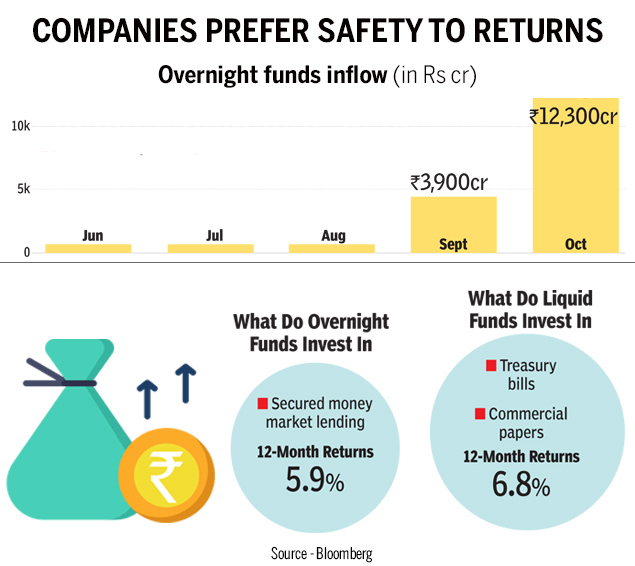
From: December 5, 2018: The Times of India
Corporate treasury departments in India have become so concerned about credit risk that they are increasingly parking their cash in securities maturing overnight. Assets with overnight funds soared to Rs 12,300 crore ($1.8 billion) last month, from Rs 3,900 crore in September, as companies chose safety over returns in the wake of a rare debt default, by the IL&FS Group. Some liquid funds lost as much as 5% — or half a year’s worth of gains — in a single day. Short-term investments also reduce interest rate risks.
Investment intentions
1991-2017: promise: reality ratio
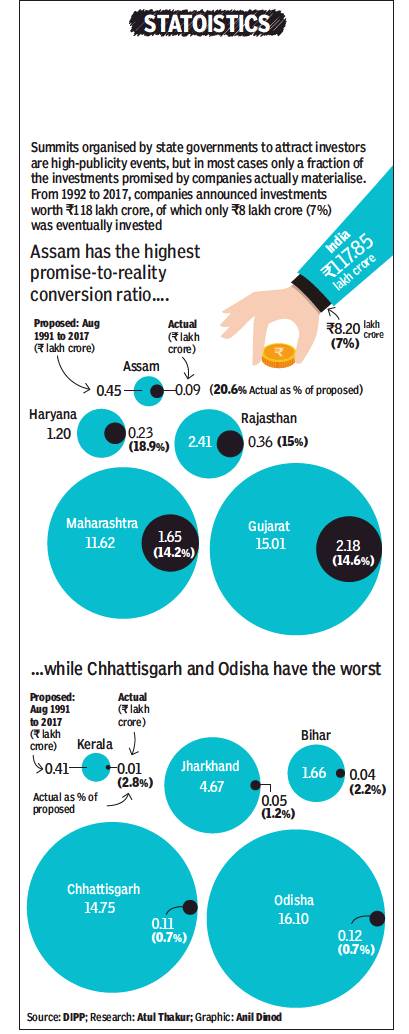
From: March 21, 2018: The Times of India
See graphic:
1991-2017: the ratio of promises (of investment made at investor summits held by state governments): reality (actual investment)
2016, “investment intentions”, state-wise
The Hindu, August 7, 2016
Karnataka emerges as investors’ favourite
Gujarat, which was ranked first among all States in 2015 for attracting maximum ‘investment intentions’ in value terms, has lost its position to Karnataka halfway through 2016.
Gujarat received investment intentions worth only Rs.21,309 crore during January-June 2016, while Karnataka — which topped the list — received over thrice that amount, or Rs.67,757 crore, during the same period, government data showed.
The Centre, which is co-ordinating efforts to rank states on ‘ease of doing business’, also maintains a State-wise break-up of investment intentions in terms of Industrial Entrepreneur Memoranda filed for de-licensed sector, Letters of Intent issued and Direct Industrial Licences granted.
Interestingly, the Rs.67,757 crore worth investment intentions received by Karnataka in the first six months of 2016 was more than the Rs.64,733 crore that Gujarat had attracted in the whole of 2015, the year when it topped the all-India list in this regard.
The Rs.64,733 crore-worth investment intentions Gujarat got was 20.81 per cent of the total investment intentions worth Rs.3,11,031 crore that India received in 2015. However, out of the Rs.1,76,738 crore worth proposed investments that India received in January-June 2016, the share of Gujarat declined to 12.06 per cent — or Rs.21,309 crore. Meanwhile, Karnataka’s share jumped from 10.18 per cent (or Rs.31,668 crore) in 2015 to 38.34 per cent (or Rs.67,757 crore) in January-June 2016. Karnataka said ‘Invest Karnataka 2016’, an investors’ meet held during February 3-5 this year, concluded with 1,201 approved projects and MoUs valued at Rs.3.08 lakh crore.
Other leading States in terms of ‘investment intentions’ during January-June 2016 were Maharashtra (Rs.15,688 crore), Telengana (Rs.13,600 crore) and Chhattisgarh (Rs.8,514 crore). In 2015, the States in the top five after Gujarat were Chhattisgarh (Rs.36,511 crore), Maharashtra (Rs.33,277 crore), Karnataka (Rs.31,668 crore) and Odisha (Rs.24,524 crore).
Even in the ‘Business Reforms Action Plan’ index 2016 (or measures taken by states to improve ease of doing business), Gujarat was sixth with a score of 53.98 per cent. Uttarakhand topped that dynamic ‘implementation scorecard’ with 63.72 per cent, followed by Rajasthan, Telengana, Chhattisgarh and Andhra Pradesh. Gujarat government officials rejected apprehensions that incidents (which even led to changes at the Chief Minister-level) — including the Patidar agitation for reservation and more recently, Dalit protests after some of them were reportedly attacked for allegedly skinning cow carcasses — are leading to lower investor interest in Gujarat.
“These numbers (on investment intentions) keep going up and down. Some big announcements could come up soon and the situation can change,” a senior Gujarat government official said, indicating that some major decisions are likely in the run-up to the Vibrant Gujarat Global Investors’ Summit that is slated to be held during January 10-13 next year.
Most of the investment intentions that Gujarat has received are getting converted into amount that is actually being spent on the ground, the official said.
Investors
The number of investors, 2019-21

From: August 5, 2021: The Times of India
See graphic:
The number of investors in India, 2019-21
Government/ PSU vis-à-vis private investors: 2014-23
Soumya Kanti Ghosh, Oct 5, 2023: The Times of India

From: Soumya Kanti Ghosh, Oct 5, 2023: The Times of India
The Indian economy logged a growth rate of 7.8% in the April-June quarter (Q1FY24). Importantly, capacity utilisation in the manufacturing space had touched a decade high at 76.3% as of March 2023.
The Indian economy logged a growth rate of 7.8% in the April-June quarter (Q1FY24). Importantly, capacity utilisation in the manufacturing space had touched a decade high at 76.3% as of March 2023.The Q1FY24 GDP numbers reaffirm that the gross capital formation, or investment, continued to be buoyant. In fact, the investment subset of the expenditure component of GDP has had perhaps the best run among all heads for the 13-quarters ended Q1FY24, with an average growth of 8%, while consumption grew at an average rate of 5% and net trade balance at 0.3% over the same period. Against this backdrop, there is this oft repeated question: How much of this investment is being driven by different segments, public, private and the household sector? Alternatively, how much of this is being driven by sectors: Industry, agriculture and services? In nominal terms, India’s investment at 2018-19 pre-pandemic level was ₹64 lakh crore, and it climbed to ₹85 lakh crore in 2022-23. While as a percentage of GDP it is still lower than 2018-19 levels, India’s investment has staged a remarkable recovery post-pandemic, rising like a phoenix from ₹55 lakh crore in 2020-21 to ₹85 lakh crore in just two years.What’s driving this renewal of investment?Industry, with a 32% share in total incremental investment for the four-year period ended 2022-23. In other words, from the last pre-pandemic year to the current period. It was at 25% for the five-year period ended 2018-19.Clearly, there is a concerted effort to push investment in manufacturing, as also reflected in several initiatives GOI has taken in the last couple of years like the PLI scheme.
However, there is more to the investment story. For the four-year period ended 2022-23, incremental investment by the private corporate sector was at ₹7 lakh crore as against ₹7.5 lakh crore for the five-year period ended 2018-19. Therefore, private corporate sector investment has thus already surpassed the pre-pandemic level if adjusted for five years. Over the same time period, household investment was at ₹9.3 lakh crore (₹8.9 lakh crore) and government investment (GOI+states) was at ₹4.2 lakh crore (₹2.8 lakh crore). The data shows it’s fallacious to argue private investment hasn’t picked up.Most importantly, consolidated private sector investment was at ₹16.3 lakh crore during FY20-23 as against ₹16.4 lakh crore in the pre-pandemic period of FY15-19. Let’s turn to the household sector. In the national accounts household sector includes, apart from individuals, all non-government and non-corporate businesses such as sole proprietorships, partnerships, and non-profit institutions. To a large extent, therefore, this sector reflects conditions in the informal sector. The narrative of ‘all is not well within the informal sector after the pandemic’ is not exactly backed by data.
The real story is the sharp contraction in investment over the same time periods by the public sector institutions from a high of ₹3.1 lakh crore to just ₹80,000 crore post-pandemic. The good thing is that public sector units have reversed such a declining trend in investment since 2021-22 and invested an additional ₹1 lakh crore, on the back of a push by the government.One good thing that has happened in the investment breakdown is the slide in share of valuables in recent years. Also, the rise in share of investment in other services like healthcare, sports etc is encouraging.So, what’s next for investment?First, the order book position of PSUs is now ₹7.77 lakh crore (for select set of companies) as of June 2023. It was ₹6.7 lakh crore a year ago. Some of the big players in the capital goods/construction space reported an order book position of up to five times annual revenue, which reflects a strong demand pipeline ahead. Second, the private sector has already shown intent with an all-time high new investment announcements of ₹37 lakh crore in 2022-23 (₹20 lakh crore a year ago). In Q1FY24 also, the investment momentum continued with announcements exceeding ₹7 lakh crore, 15% higher than the same period previous year. Third, in Q1FY24, the private sector as represented by more than 3,000 listed firms, announced higher operating profitability (EBIDTA), reflecting robust performance.Finally, housing loans are at 76% of retail loans in the current fiscal, indicating that household investment in physical assets will continue to be buoyant. This is again good news for overall investment trends in the household sector.
Women investors
2017-20
August 9, 2021: The Times of India
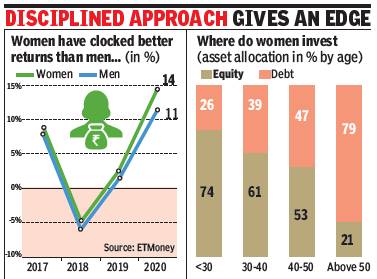
From: August 9, 2021: The Times of India
...get better returns on investments than men
Mumbai:
Women investors were found to be more disciplined than their male counterparts in terms of following rules of investing, a survey by ETMoney has found. From adhering to asset allocation according to their age to sticking to a systematic investment plan (SIP) — women investors beat men. And this eventually helped the women record better returns over four years, the survey found. The results of the survey were released, which was International Women’s Day.
In each of the years between 2017 and 2020, women as a group on ETMoney had earned better returns compared to male investors. This was true even for 2018, which showed marginally negative returns for both the groups. In 2020 too, the year that tested the mettle of all investors because of the Covid-induced global pandemic, women did better. The survey results showed that in 2020, while women recorded returns of nearly 14%, the male investors earned a little over 11%.
ETMoney found that women were far more determined than men when investing as well. “Once they start an SIP, they tend to stay on the path far more often than men and, as a result, are more likely to meet their goals,” it said. The survey further revealed that women investors use tax-saving options more intelligently than men. An average 15% of women’s portfolio was in equitylinked savings schemes (ELSS), which helped them combine tax-saving with wealth-creation, as compared to 12% of men, the survey said.
The survey noted that women investors have a near-optimal asset allocation for their age. The basic formula for investments is that the equity portion’s percentage should be 100 less the age of the investor. So, for a 30-year-old, 70% of the portfolio should be in equities (100-30). The survey found women investors were more likely to adhere to this rule. “This shows their understanding of the risk of each asset class and the importance of asset allocation to have optimal risk-reward mix,” the survey said.

